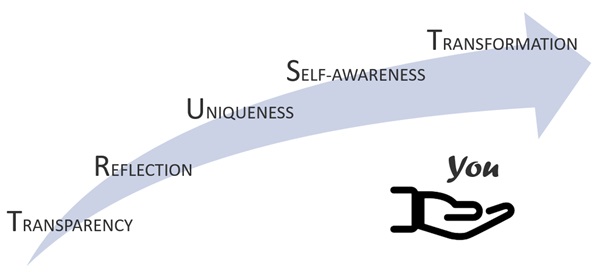A Coaching Model By Diana Osak, Executive Coach, POLAND
Three Fundamental Elements for Powerful Coaching Combine in the Word TRUST
The niche I’m focusing on is highly-skilled professional women between 27-45 years old with experience living and working abroad. My typical client calls herself or aspires to become a leader. She “dares more”, which means she wants to climb the career leather, lead people, grow professionally, or be better or more recognized in her current role. On a personal level, she is looking for the alignment between the international experience as an ex-pat and her authentic values, which often come from the country of her origin. Therefore, I will be offering a combination of business and life coaching. The main topics that my clients are dealing with are cultural transition, adaptation to the new place, networking, sense of belonging, verbal and non-verbal communication, and homesickness.
The reason I chose this niche lies in my personal experience. For the last 17 years, I have been living and working in 5 different countries, exploring different cultures, languages, and business behavior differences. I find the international women extremely courageous, inspiring, and reach in life experiences. They often need to face challenges alone and suffer a lack of understanding from their international environment or people in their home country. Some of them suffer from a lack of confidence.
As an International Leadership Coach, I will be focusing my sessions on three objectives:
- Empowering women to build their confidence and their global leadership skills
- Inspiring clients to discover their unique strengths and to consciously apply them in the work environment
- Motivating women to create their own, personal brand and long-term professional strategy
As a result of COVID-19 and the current business trends, I would like to specialize in providing my services online; therefore, I’m working on the visual tools that could make my coaching practice more efficient and comfortable for the client.
During my coaching sessions, I identified three elements, which I consider fundamental for powerful coaching to take place. These are intimacy, openness, and honesty. Instinctively, these elements combine in the word TRUST. As defined by Stephen M. R. Covey:
Trust is the glue of life. It’s the most essential ingredient in effective communication.

I believe the word TRUST has very deep meaning for my niche because it creates a virtual enclave, where the clients can feel comfortable and secure. The idea is that they trust their coach, trust the coaching process and what is the most significant…trust themselves.
The Five Elements of the TRUST Explanation With Visual
TRUST Coaching Model is a process designed around YOU (the client) as the center of the model. I identified five stages that will help the client to advance in their coaching cycle. The five elements of the TRUST Coaching Model can be present in one session or evolve as the result of a long-term coach-client relationship. Each of them is the step towards a change and transformation.

Transparency
This first stage is the conversation opener. The client needs to feel secure, safe, and understood to open up and share what is on her mind. In this crucial first step, my role is to create an unbiased, open and safe environment, free of judgment, bias, and stereotypes. I want to make sure the client feels relaxed and ready to share her thoughts, emotions, and desires. The transparency stage is the essential fundament for building trustworthy client-couch relations, which will lead to the next steps in the TRUST model.
Reflection
The second stage -reflection, allows my client to connect with her deepest self. This is the time to pause, take a breath, and immerse into her deepest feelings, emotions, and values. This is the moment to answer the questions: How do I feel? What is causing my feelings or emotions? Where does it come from? How do I want to feel? What stands in the way to feel better? Often in the reflection stage, I will encourage the client to put herself to evaluate and measure where she is right now and where she wants to get.
Uniqueness
Even though my clients are all female ex-pats, and they share similar ambitions, each of them is unique. They have different drives, aspirations, values, beliefs, and desires… They want to achieve common objectives, but they want to do it in their unique way. My goal is to convert their impediments into their strengths, building on their unique life experiences and using their unique skills.
Self-Awareness
In the self-awareness stage, my clients are realizing what their superpowers are and how to use them effectively. It is the moment of building up self-ego, self-esteem, or self-confidence. This phase of coaching is focused on YOU: your strengths, your powers, your uniqueness. It also involves deep reflection on how these traits can be used to address a given problem, issue, or challenge that my client is facing. The purpose of the self-awareness stage is to empower and strengthen my clients’ mindsets and their focus on the outcome and next steps.
Transformation
The final stage of my coaching practice is a transformation, which is the moment of lightning. This could be an idea, a thought, a realization, or a self-discovery. This is the moment of change, in which a client decides, takes a new challenge, gets the courage to move forward, shifts her original plan… In the transformation stage, the client feels powerful to take the next step. She has a plan in her mind and a strong belief that it will work.
As an International Leadership Coach, I hope my clients can use the TRUST model not only in my coaching sessions but also in their professional and private life. As Stephen M. R. Covey states in his book Speed of Trust “the first job of a leader—at work or home—is to inspire trust. It’s to bring out the best in people by entrusting them with meaningful stewardships, and to create an environment in which high-trust interaction inspires creativity and possibility.”
Learn How to Create Your Own Coaching Model
Your Coaching Model reflects your values,
philosophies and beliefs and must communicate who you will coach
and the problems you will solve.
Covey, Stephen M.R. Speed of Trust
